 Copyright 2020 by Rockridge Press, Emeryville, California No part of this publication may be reproduced, stored in a retrieval system, or transmitted in any form or by any means, electronic, mechanical, photocopying, recording, scanning, or otherwise, except as permitted under Sections 107 or 108 of the 1976 United States Copyright Act, without the prior written permission of the Publisher. Requests to the Publisher for permission should be addressed to the Permissions Department, Rockridge Press, 6005 Shellmound Street, Suite 175, Emeryville, CA 94608. Limit of Liability/Disclaimer of Warranty: The Publisher and the author make no representations or warranties with respect to the accuracy or completeness of the contents of this work and specifically disclaim all warranties, including without limitation warranties of fitness for a particular purpose. No warranty may be created or extended by sales or promotional materials. The advice and strategies contained herein may not be suitable for every situation. This work is sold with the understanding that the Publisher is not engaged in rendering medical, legal, or other professional advice or services.
Copyright 2020 by Rockridge Press, Emeryville, California No part of this publication may be reproduced, stored in a retrieval system, or transmitted in any form or by any means, electronic, mechanical, photocopying, recording, scanning, or otherwise, except as permitted under Sections 107 or 108 of the 1976 United States Copyright Act, without the prior written permission of the Publisher. Requests to the Publisher for permission should be addressed to the Permissions Department, Rockridge Press, 6005 Shellmound Street, Suite 175, Emeryville, CA 94608. Limit of Liability/Disclaimer of Warranty: The Publisher and the author make no representations or warranties with respect to the accuracy or completeness of the contents of this work and specifically disclaim all warranties, including without limitation warranties of fitness for a particular purpose. No warranty may be created or extended by sales or promotional materials. The advice and strategies contained herein may not be suitable for every situation. This work is sold with the understanding that the Publisher is not engaged in rendering medical, legal, or other professional advice or services.
If professional assistance is required, the services of a competent professional person should be sought. Neither the Publisher nor the author shall be liable for damages arising herefrom. The fact that an individual, organization, or website is referred to in this work as a citation and/or potential source of further information does not mean that the author or the Publisher endorses the information the individual, organization, or website may provide or recommendations they/it may make. Further, readers should be aware that websites listed in this work may have changed or disappeared between when this work was written and when it is read. For general information on our other products and services or to obtain technical support, please contact our Customer Care Department within the United States at (866) 744-2665, or outside the United States at (510) 253-0500. Rockridge Press publishes its books in a variety of electronic and print formats.
Some content that appears in print may not be available in electronic books, and vice versa. TRADEMARKS: Rockridge Press and the Rockridge Press logo are trademarks or registered trademarks of Callisto Media Inc. and/or its affiliates, in the United States and other countries, and may not be used without written permission. All other trademarks are the property of their respective owners. Rockridge Press is not associated with any product or vendor mentioned in this book. Interior and Cover Designer: Rachel Haeseker
Art Producer: Tom Hood
Editor: Natasha Yglesias ISBN: Print 978-1-64611-319-4 | eBook 978-1-64611-320-0
R0 Contents If youre reading this workbook on a touch-screen device, you can add notes and highlight text just like you would in a physical workbook.
Some sections will prompt you to write in answers or personal responses. Its easygive it a try right here: ___________. With your finger, tap and hold for a few moments on the line above. Depending on the device youre using, an icon such as a magnifying glass will appear. Lift your finger and youll see an options menu. Select Note (or Notes) to add and save your own text.
When youre done, an icon or highlighted area will remain, which you can always return to and tap if you want to reopen and read or edit your note. The same tap-and-hold options menu offers Highlight or Color, which you can select if you want to highlight a passage or check a box. Experiment with it: By swiping your finger before releasing you can select entire sentences or paragraphs. The options menu also offers Bookmark for when you want quick access back to certain pages. This method is the same on nearly all touch-screen ebook devices, but some have slight variations. If youd like more information specific to the device youre holding in your hands, a quick online search will yield best results.
Hey, everyone! Thanks for picking up this book. Im a native New Yorker who started on an English teaching journey in 1994 in Sendai, Japan. At first, I thought teaching English would be easy. Boy, was I surprised! Sure, English has a lot of grammar rules, but I soon realized that in many situations, those rules, their exceptions, and even some non-rules made learning and teaching English pretty tough. For example, I knew that in English, we use many before countable nouns ( many pens, many people ) and much before uncountable nouns ( much rain, much love ). But one day, one of my students said, I ate much food last night, which sounded weird to me.
When I tried to figure out why, I couldnt find the answer in any of the grammar books I had. I realized that while most books will teach you how to make the grammar (the structure), they dont teach you how to apply it. Thats how I became motivated to write this book. The lessons here will help you become more articulate and confident using English in your writing and everyday English conversations. What Does This Book Mean by Functional English Grammar? When something is functional, its both practical and useful. The cat or dog on your coffee mug looks nice, but its neither practical nor useful.
Your mug will work just as well without the graphics. I wanted to write a book that would help clear up questions you may have about grammar but also give you opportunities to practice using grammar in real everyday situations. Applying what you learn is key to remembering and mastering anything. You have to just do it , as a certain sportswear company says. You can read all about swimming and spend hours watching swimming videos on YouTube, but to become a swimmer, you have to actually jump in the pool. So, welcome to your new swimming area! So, what actually is grammar? The Merriam-Webster dictionary defines grammar as the study of the classes of words, their inflections, and their functions and relations in the sentence.
This definition really describes everything you need to know about grammar in order to write and speak English with proficiency. The classes of words are the parts of speechnouns, adjectives, prepositions, conjunctions, pronouns, etc. Inflections refer to the way we use words to account for tense (past, present, future), mood, gender, voice, etc. And functions and relations are how words work together in a sentence. Theres a saying that you dont need to know how a clock works in order to tell time. The same goes for grammar.
The different sections of this book are categorized by name so they can be presented in an organized way, but dont get caught up in the terminology. You dont need to remember the term countable noun you just need to know that some nouns are countable, like dogs or cars, and that uncountable nouns refer to nouns that cannot be counted, like air. Learn the rules, practice with the exercises provided here, and keep this book on hand for easy reference! How to Use This Book This book is divided into two parts. The first part is a collection of the most practical and commonly used English grammar patterns. Each section is designed to give you a concise review of that grammar pattern, including its structure, meaning, and, most importantly, usage. At the end of each lesson, youll find an exercise to give you some practice.
You can check your answers with the answer key at the back of the book. Once you feel comfortable with the grammar lessons, you can move on to part two. There, youll find real-world scenarios in which you can apply what you learned in part one. These scenarios cover everything from social situations, school, and work life to creative writing. This book is not a complete guide to English grammar. There are lots of those kinds of books on the market.
Next page
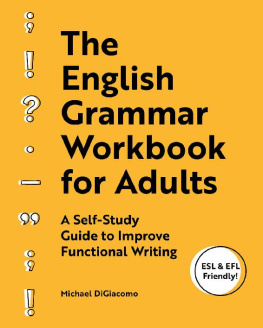


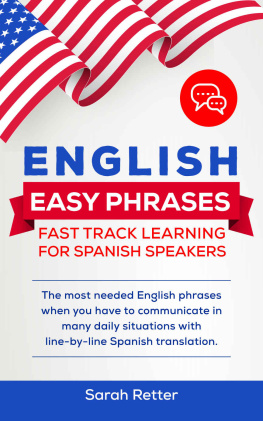

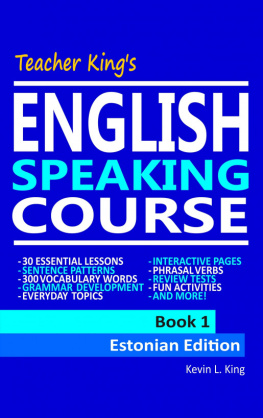

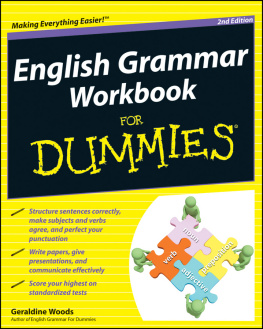
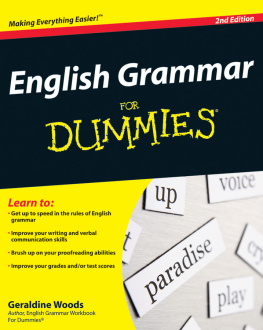
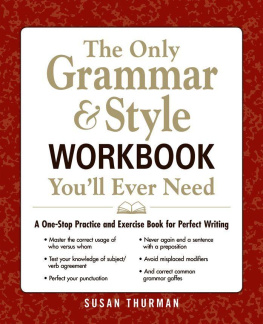

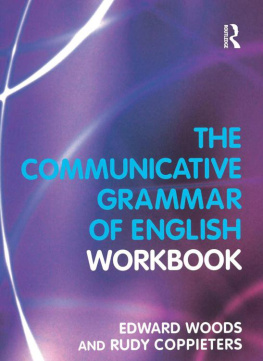
 Copyright 2020 by Rockridge Press, Emeryville, California No part of this publication may be reproduced, stored in a retrieval system, or transmitted in any form or by any means, electronic, mechanical, photocopying, recording, scanning, or otherwise, except as permitted under Sections 107 or 108 of the 1976 United States Copyright Act, without the prior written permission of the Publisher. Requests to the Publisher for permission should be addressed to the Permissions Department, Rockridge Press, 6005 Shellmound Street, Suite 175, Emeryville, CA 94608. Limit of Liability/Disclaimer of Warranty: The Publisher and the author make no representations or warranties with respect to the accuracy or completeness of the contents of this work and specifically disclaim all warranties, including without limitation warranties of fitness for a particular purpose. No warranty may be created or extended by sales or promotional materials. The advice and strategies contained herein may not be suitable for every situation. This work is sold with the understanding that the Publisher is not engaged in rendering medical, legal, or other professional advice or services.
Copyright 2020 by Rockridge Press, Emeryville, California No part of this publication may be reproduced, stored in a retrieval system, or transmitted in any form or by any means, electronic, mechanical, photocopying, recording, scanning, or otherwise, except as permitted under Sections 107 or 108 of the 1976 United States Copyright Act, without the prior written permission of the Publisher. Requests to the Publisher for permission should be addressed to the Permissions Department, Rockridge Press, 6005 Shellmound Street, Suite 175, Emeryville, CA 94608. Limit of Liability/Disclaimer of Warranty: The Publisher and the author make no representations or warranties with respect to the accuracy or completeness of the contents of this work and specifically disclaim all warranties, including without limitation warranties of fitness for a particular purpose. No warranty may be created or extended by sales or promotional materials. The advice and strategies contained herein may not be suitable for every situation. This work is sold with the understanding that the Publisher is not engaged in rendering medical, legal, or other professional advice or services.